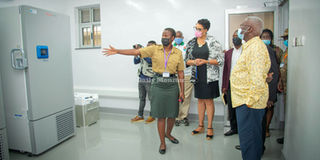UWA gets new laboratory to diagnose animal diseases

UWA official shows the laboratory equpment to Minister Tom Butime and US Ambassador to Uganda Natalie Brown. Photo | Enid Ninsiima
What you need to know:
- The well-furnished and equipped laboratory was constructed at a tune of Shs2 billion with funding from the United States of America under the Risk Reduction Agency.
Following the increased cases of zoonotic diseases among the wildlife and humans along Queen Elizabeth national park, the Uganda Wildlife Authority (UWA) has established a modern biosafety laboratory level II (BSL2) at Mweya in Kasese to enable it to handle emerging infectious diseases in Uganda.
The well-furnished and equipped laboratory was constructed at a tune of Shs2 billion with funding from the United States of America under the Risk Reduction Agency.
“With this well-equipped laboratory, UWA will be able to detect diseases in animals to ensure optimum health for humans, animals including wildlife,” Ms Natalie Brown, the Ambassador of USA to Uganda said on Wednesday while commissioning the laboratory.
She said the laboratory will act as a research institute that will develop, innovate, build human capital development, disease surveillance, and apply appropriate veterinary interventions.
"I thank the USA government for supporting animal disease prevention through the provision of appropriate diagnostic facilities," Ms Natalie said.
The Minister for Tourism, Wildlife, and Antiquities Tom Butime said this is the first laboratory in the country and the government will ensure its funding for sustainability.
He observed that various factors such as climate change, globalization, urbanisation are the leading causes of zoonotic diseases among animals.
The Executive Director UWA, Mr Sam Mwandha, said in 2004 they lost 303 hippos to anthrax in Queen Elizabeth National Park, and in 2009, 2.5 per cent of the bats in Maramagambo forest died of Marburg.
He said the new laboratory will also be used by Virunga national park under the Great Virunga Transboundary collaboration in order to save both humans and wildlife within and outside the country after being accredited by the National Council of Science and Technology.
Mr Micheal Omodo, the senior laboratory scientist in the ministry of agriculture said there is an infection of brucellosis disease among the animals living in the communities that border with Queen Elizabeth national park.
"We sampled 227 animals in the sub-counties of Katerera, Magambo, Kirungu Ryeru, Kirugu, and Katanda and found two goats out of 109 sampled positive, 01 sheep out of 105 tested positive and 01 out of 11 pigs tested positive," he said.




